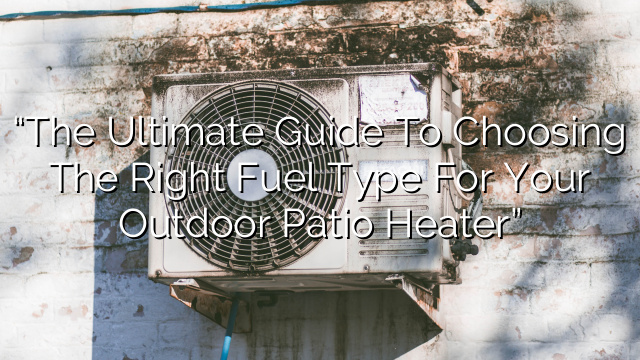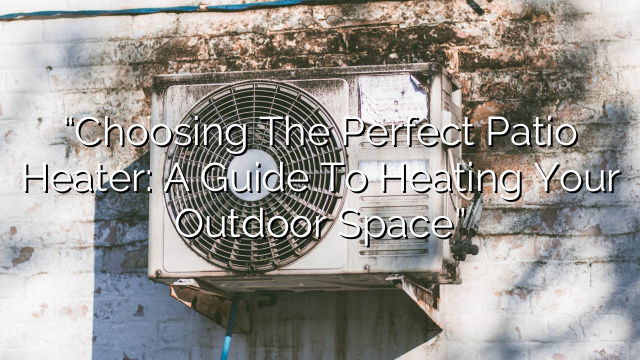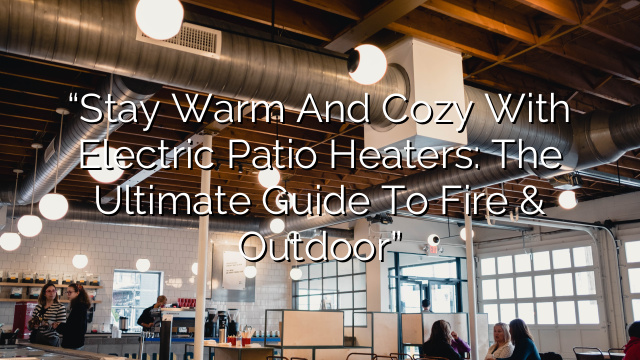Introduction
As the weather starts to cool down, having a patio heater for your outdoor space becomes essential. A patio heater can extend your outdoor living season, allowing you to enjoy your patio or deck even in chilly evenings. However, with so many options available in the market, choosing the right patio heater can be overwhelming. In this guide, we will walk you through the factors to consider when selecting a patio heater for your outdoor space.
1. Fuel Type
The first consideration when choosing a patio heater is the fuel type. Patio heaters typically come in three fuel options: propane, natural gas, and electric. Each fuel type has its pros and cons, and the choice will depend on your preferences and the availability of fuel sources in your area.
- Propane: Propane patio heaters are the most popular choice as they are portable and do not require a fixed fuel source. They usually come with a propane tank that can be easily replaced or refilled. One tank can provide several hours of heat. The drawback is that propane tanks need to be regularly replaced or refilled.
- Natural Gas: Natural gas patio heaters are typically stationary and need to be connected to a natural gas line. They are convenient as they do not require refilling or replacing fuel tanks. However, installation costs can be high, and they cannot be moved once installed.
- Electric: Electric patio heaters are powered by electricity and can be plugged into an outdoor electric outlet. They are easy to use and do not require any fuel source. However, they may not provide as much heat as propane or natural gas heaters, and you need to have an outdoor power source nearby.
2. Heat Output
When selecting a patio heater, consider the heat output it can provide. The heat output is usually measured in BTUs (British Thermal Units). The higher the BTU rating, the more heat the patio heater can produce. Keep in mind the size of your outdoor space and the level of heat you desire. A general rule of thumb is to have 20 BTUs per square foot of space. So if your patio is 200 square feet, you will need a patio heater with a minimum output of 4,000 BTUs.
3. Design and Style
Patio heaters come in various designs and styles, so you can find one that matches your outdoor space and personal taste. Consider the overall aesthetics of your patio and choose a patio heater that complements the style. Common design options include freestanding patio heaters, tabletop patio heaters, and wall-mounted patio heaters. Freestanding heaters are versatile and can be moved around, while tabletop heaters are smaller and can be placed on a table for a more intimate setting. Wall-mounted heaters are ideal for limited outdoor spaces.
4. Safety Features
Safety should be a top priority when choosing a patio heater. Look for models with safety features such as a tip-over switch, which automatically shuts off the heater if it is accidentally knocked over. Some heaters also have a flame failure device, which turns off the gas supply if the flame goes out. Additionally, consider heaters with a protective grate or shield to prevent direct contact with the heating element.
5. Ease of Use and Maintenance
Choose a patio heater that is easy to use and maintain. Look for models with user-friendly controls and ignition systems. Some patio heaters may require assembly, so consider the level of difficulty and whether you are comfortable with it. Also, check the maintenance requirements and make sure you are willing to invest the time and effort in keeping the heater in good condition.
6. Budget
Consider your budget when selecting a patio heater. Patio heaters come in a wide price range, so determine how much you are willing to spend. Keep in mind that higher-priced models often have better quality, durability, and additional features, but you can still find good options within a lower budget. Compare prices and read reviews to ensure you are getting the best value for your money.
FAQs
Q1. Can I use a patio heater under a covered patio?
A: It is generally safe to use a patio heater under a covered patio, but you should check the manufacturer’s guidelines for specific instructions. Ensure that the area is well-ventilated to prevent the buildup of fumes. Keep the heater a safe distance away from flammable materials and do not place it directly against walls or other structures.
Q2. Can I leave my patio heater outside in the rain?
A: Most patio heaters are designed to withstand outdoor conditions and can be left outside in the rain. However, it is recommended to cover or store the heater when not in use to protect it from excessive moisture and prolong its lifespan. If you live in an area with heavy rainfall, consider purchasing a patio heater with weather-resistant features.
Q3. How much propane does a patio heater use?
A: The propane consumption of a patio heater varies depending on the BTU rating and usage time. On average, a patio heater with a 40,000 BTU rating can consume approximately one gallon of propane per hour. However, this may vary, so it is always a good idea to check the manufacturer’s specifications for the specific model you are considering.
Q4. Can I use natural gas patio heaters indoors?
A: No, natural gas patio heaters should not be used indoors. They are designed for outdoor use only, as they produce carbon monoxide, which can be dangerous in enclosed spaces. It is important to have proper ventilation when using any type of patio heater to avoid the risk of carbon monoxide poisoning.
Q5. How do I clean my patio heater?
A: To clean your patio heater, first, turn off the fuel source and allow the heater to cool completely. Use a soft cloth or brush to remove dust and debris from the surface. You can also use a mild detergent mixed with water to clean any stubborn stains. Avoid using abrasive cleaners or harsh chemicals, as they may damage the finish of the heater. Always follow the manufacturer’s instructions for cleaning and maintenance.
Conclusion
Choosing the right patio heater for your outdoor space is essential to ensure maximum comfort and enjoyment during cooler seasons. Consider the fuel type, heat output, design and style, safety features, ease of use and maintenance, and your budget when making your decision. With the right patio heater, you can create a cozy and inviting outdoor environment that can be enjoyed even when the temperature drops.














